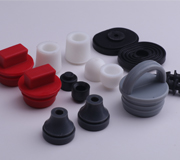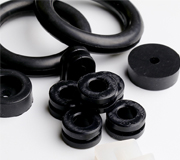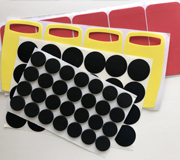The following news is quoted from www.rubbernews.com.
CINCINNATI—ISO certification has its benefits, but other business approaches might be more useful, according to Charlie Neff, president of Friction Coating Corp. in Clinton Township, Mich.
If customers aren't requesting ISO certification, looking toward lean manufacturing practices could have a bigger impact, Neff said in his presentation "ISO Certification—I jumped in with both feet, should you?" at the annual Rubber Roller Group meeting in Cincinnati.
Neff started by covering the basics of what ISO certification looks like with the current ISO 9001:2015 standard published by the International Organization of Standards, which has published 21,740 standards, he said.
"It's good night time reading," Neff said.
Meeting the level of ISO 9001's standards means a company can be certified that its quality management system complies with those requirements. Neff also discussed a few common myths about ISO qualifications. ISO certification cannot be applied to a specific person or a product, and the organization isn't a group to be joined. Also, the term "ISO-compliant" gets used around the industry, usually where a company has done a self-audit on compliance, but it's an unofficial term.
The ISO standards require documentation of procedures and quality objectives, actually going out into the shop with a clipboard, Neff said.
"It's an informative experience," he said. "Undoubtedly, you will get to your shop floor, and you will learn that they are doing it exactly like you told them to do it, which may not be how you like it done today."
Identifying problems
The certification process also requires continuous process improvements, which involves the Deming cycle of plan, do, check and act, he said.
"Once you've defined all your processes, you can then sit down in a calm, cool, collected environment and identify opportunities for improvements," he said.
Once a problem is identified, the root cause for the problem can be found and some tentative solutions can be devised, he said. Going into planning, an experiment can be set up and followed through, and the results can be analyzed to see if the plan accomplished the original goal. Neff said he prefers react instead of act because "typically when you're doing these experiments you'll learn that your first best guess wasn't the best. You need to do some reiterations to help with a solution."
An ISO auditor also will look for strategic planning, he said. Another process that can be helpful with this requirement is what Neff calls the SWOT test, which stands for strengths, weaknesses, opportunities and threats. They'll also ask about how customer satisfaction is monitored and addressed, through processes such as surveys, phone calls and trade show visits.
Neff talked about some of the reasons that a company seeks ISO certification, such as a customer requirement or marketing outreach, though it doesn't always bring the strongest reaction.
"I have to say that I've stopped counting the number of screen-saver faces that I've seen when I brag that I'm ISO-certified," he said.
But if a customer isn't asking for ISO certification and the company's future planning doesn't require it, there are other ways to get some of the benefits of the process, Neff said.
Building lean processes
Instead of putting time and money into ISO certification, Neff suggested putting the effort into establishing lean practices, such as the ones developed for Toyota by Taiochi Ono in the 1950s. Ono studied American automobile manufacturing plants and found places for improvement. He folded support and inspection staff into production, and developed team-based approaches to regulation and processes.
"Taiochi taught them how to use the Deming cycle. You find the problem, come up with a solution, test it, monitor it, react. He did this with every problem that surfaced in his manufacturing operation," Neff said. "I point this out because this is 1950. About 65 years later, ISO incorporates the Deming cycle into 9001."
Ono took on the idea of never stopping the manufacturing line, finding that the reworking area took up valuable space and time in a plant. Instead, if a problem couldn't be solved on the line, a pull cord stopped the process, and the entire team gathered to fix the issue. Neff said Ono's approach used five "whys," in that tracing the problem back to its source required asking "why" five times, and then dealing with the systemic problem that led to the original issue.
Ono also came up with his own approach to the idea of waste as anything that requires a resource that does not add value for the customer, Neff said. That includes issues that results in scrap or rework, but also production of items before the customer needed them, meaning that the product would sit in inventory. The customer could be an end user or another stop along the production line. Dealing with an onslaught of waste was overwhelming, so Ono prioritized opportunities that satisfied customer needs.
Neff said the system became known as the Toyota Production System, but eventually morphed into lean manufacturing and Lean Six Sigma.
The general return on investment for incorporating Ono's processes is about three times, he said, and can happen within 12 to 18 months.
"What you'll typically see in a lean effort is a majority of the return on investment is in the beginning, but it's a philosophy that sticks with the company throughout," Neff said.
The first step to pursuing the lean process is to prepare a value stream analysis, which is a process flow diagram that helps identify improvement opportunities throughout the entire operation from raw materials to shipped goods, Neff said.
"You'll notice that I said the entire operation," Neff said. "The value stream analysis is a visual tool which helps you highlight where value is added and where waste is generated."
Once a value stream analysis is created, it provides a starting point to plan for future improvements and projects, he said. Using tools like that to start a lean process means developing a continuous improvement cycle.
"So now you might ask, you came to an ISO presentation and a lean presentation broke out," Neff said.
As ISO provisions move forward, the purpose of the standards is to develop a strategic approach and weapon to improve overall effectiveness by providing guidelines to improving operation, he said. ISO certification isn't necessary for every business, but the process can help streamline and improve production. Incorporating lean manufacturing processes can reap those benefits without the stress of certification, and the two entities are coming closer together over time.
"They've come toward lean in a couple places that I've mentioned today, and it's my prediction that one day in the future, we'll open the ISO 9001:2050 revision and it'll say 'See lean.'












